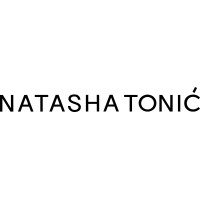15 Most Sustainable Activewear Brands: The Conscious Consumer’s Guide
Affiliate Disclosure
Hey fellow impactful ninja ?
You may have noticed that Impactful Ninja is all about providing helpful information to make a positive impact on the world and society. And that we love to link back to where we found all the information for each of our posts.
Most of these links are informational-based for you to check out their primary sources with one click.
But some of these links are so-called "affiliate links" to products that we recommend.
Why do we add these product links?
First and foremost, because we believe that they add value to you. For example, when we wrote a post about the environmental impact of long showers, we came across an EPA recommendation to use WaterSense showerheads. So we linked to where you can find them. Or, for many of our posts, we also link to our favorite books on that topic so that you can get a much more holistic overview than one single blog post could provide.
And when there is an affiliate program for these products, we sign up for it. For example, as Amazon Associates, we earn from qualifying purchases.
What do these affiliate links mean for you?
First, and most importantly, we still only recommend products that we believe add value for you.
When you buy something through one of our affiliate links, we may earn a small commission - but at no additional costs to you.
And when you buy something through a link that is not an affiliate link, we won’t receive any commission but we’ll still be happy to have helped you.
What do these affiliate links mean for us?
When we find products that we believe add value to you and the seller has an affiliate program, we sign up for it.
When you buy something through one of our affiliate links, we may earn a small commission (at no extra costs to you).
And at this point in time, all money is reinvested in sharing the most helpful content with you. This includes all operating costs for running this site and the content creation itself.
What does this mean for me personally?
You may have noticed by the way Impactful Ninja is operated that money is not the driving factor behind it. It is a passion project of mine and I love to share helpful information with you to make a positive impact on the world and society. However, it's a project in that I invest a lot of time and also quite some money.
Eventually, my dream is to one day turn this passion project into my full-time job and provide even more helpful information. But that's still a long time to go.
Stay impactful,
Amid growing concerns about the textile industry’s environmental impact, there is pressure to find greener clothes for your wardrobe, from work blazers to swimsuits. Unfortunately, fashion greenwashing makes it harder for you and all other consumers to figure out which clothing brands offer the most eco-friendly garments. So, we had to ask: Which are the most sustainable activewear brands?
The most sustainable activewear brands are Patagonia, Girlfriend Collective, Tripulse, and Finisterre, which prioritize recycled materials that are low-impact and high-performing while striving for circularity. In addition, Wolven and VAUDE reduce carbon emissions and textile waste.
Whether you are searching for some perfectly fitting bike shorts or a supportive exercise bra to add to your wardrobe without negatively impacting the soil, the water, the animals, and other people, there is a brand for you. So, let’s keep reading to learn more about the most sustainable activewear brands and how they ensure sustainable, ethical practices.
Here’s How We Selected the Most Sustainable Activewear Brands
The fast fashion industry has pushed for trendy activewear that requires frequent replacement. Yet, the environmental impacts of making and landfilling clothes can be enormous, especially with certain materials.
“Sustainable: The ability to be maintained at a certain rate or level | Avoidance of the depletion of natural resources in order to maintain an ecological balance”
Oxford Dictionary
The brands on this list were chosen based on their commitment and actions to promote sustainable practices while reducing the environmental impacts of the textile industry.
They are transparent about their materials, processes, and workforce management within their supply chain.
Some brands focus their efforts on reducing waste and optimizing natural resources while others strive to reduce the carbon footprint of their clothes.
All of these brands share the commitment to reshape the textile industry toward a more sustainable and Earth-friendly sector.
These Are the 15 Most Sustainable Active Clothing Brands
Most Sustainable Active Clothing Brands
Overall, these activewear brands are sustainable. Yet, they take various approaches to reduce environmental impacts and uphold ethical standards. Let’s dive into each brand and find out more.
Patagonia: Everyday Wear for Those Who Care
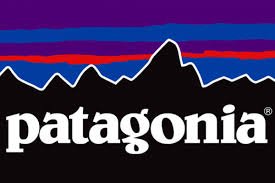
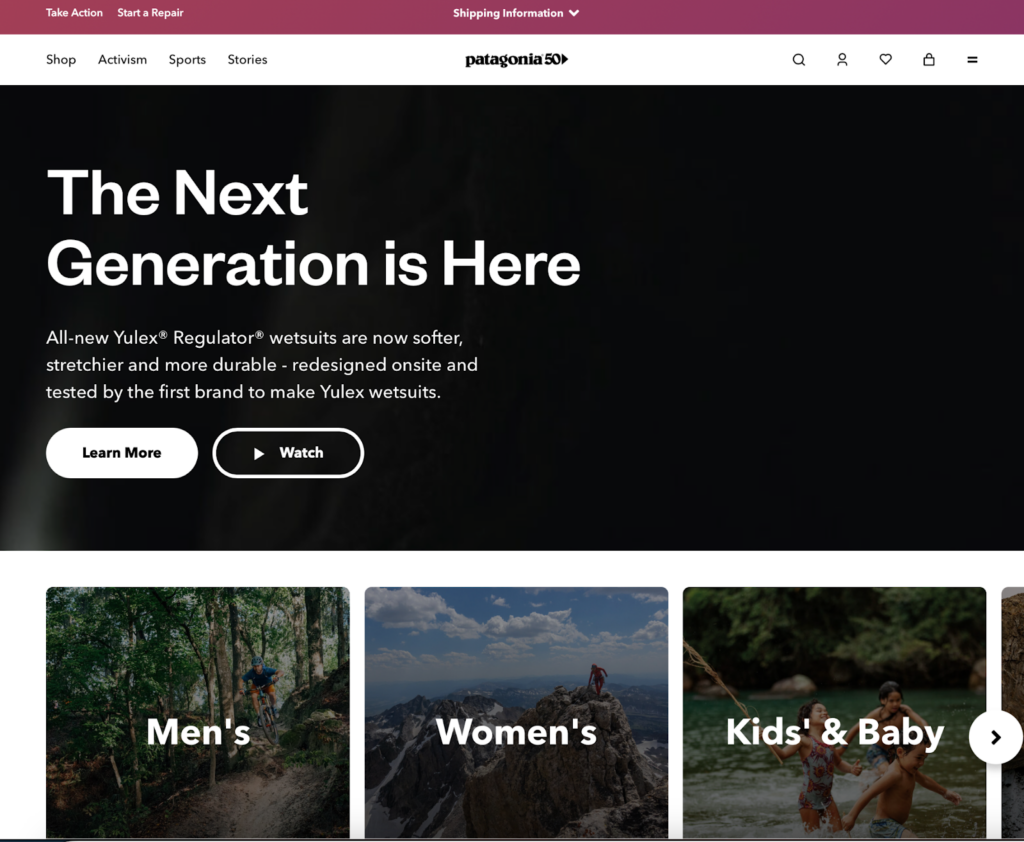
“Together, we can prioritize purpose over profit and protect this wondrous planet, our only home.”
Patagonia
🌎
How do they ensure their sustainability?
Patagonia puts sustainability at the center of their operation. They work to reduce, rather than simply offset, carbon emissions where it matters the most: in the supply chain and material manufacturing. They reduce their carbon footprint by removing high-impact virgin fossil-based fibers from their collections, using “Environmental Profit and Loss” to guide their production decision, and helping their suppliers to cut emissions. Patagonia’s fall 2023 collections are made up mostly of preferred materials (91% by fabric weight), including Regenerative Organic Certified fibers, hemp, man-made cellulose fibers, recycled cotton, and recycled polyester. On top of that, Patagonia’s Worn Wear Program encourages customers to repair and recycle their products, extending the textile lifecycle and reducing waste. Lastly, Patagonia is certified as a B Corporation and a Bluesign® brand.
🌐
How do they ensure their ethics?
Patagonia commits to fair trade practices. Through the partnership with Fair Trade USA, they currently produce 86% of their clothes in 20 Fair Trade Certified™ factories. Patagonia pays a premium for every item produced in such factories, accumulating in a fund for workers to use in their chosen community projects, whether in healthcare or parent support or to withdraw as a cash bonus. Additionally, they have various social responsibility programs to prevent harm and create positive impacts on the lives of apparel workers in their supply chain. These include the Fair Labor Association, the Living Wage Program, the Migrant Workers Program, and the Responsible Purchasing Practices. Patagonia is also fully transparent about the locations of their facilities and suppliers.
🤝
Are they part of any giving-back programs?
Since 1985, Patagonia has pledged 1% of sales annually to environmental causes. They have awarded over $89 million in cash and kind donations to domestic and international grassroots environmental groups, making a difference in their local communities. In 2022, the founder of Patagonia gave away his family’s ownership of the company to the newly created Patagonia Purpose Trust and the not-for-profit organization Holdfast Collective, ensuring that all future profits from the company are used to fight the climate and extinction crisis.
🛍️
What is their product range?
- Best for: kidswear, menswear, womenswear
- Product range: shirts, pants, jackets, blazers, hoodies, sweatshirts, T-shirts, shorts, plus-size
- Price range: $$$
- Size range: XXS–XXXL
Girlfriend Collective: Essential and Timeless Activewear Made Out of Recycled Materials

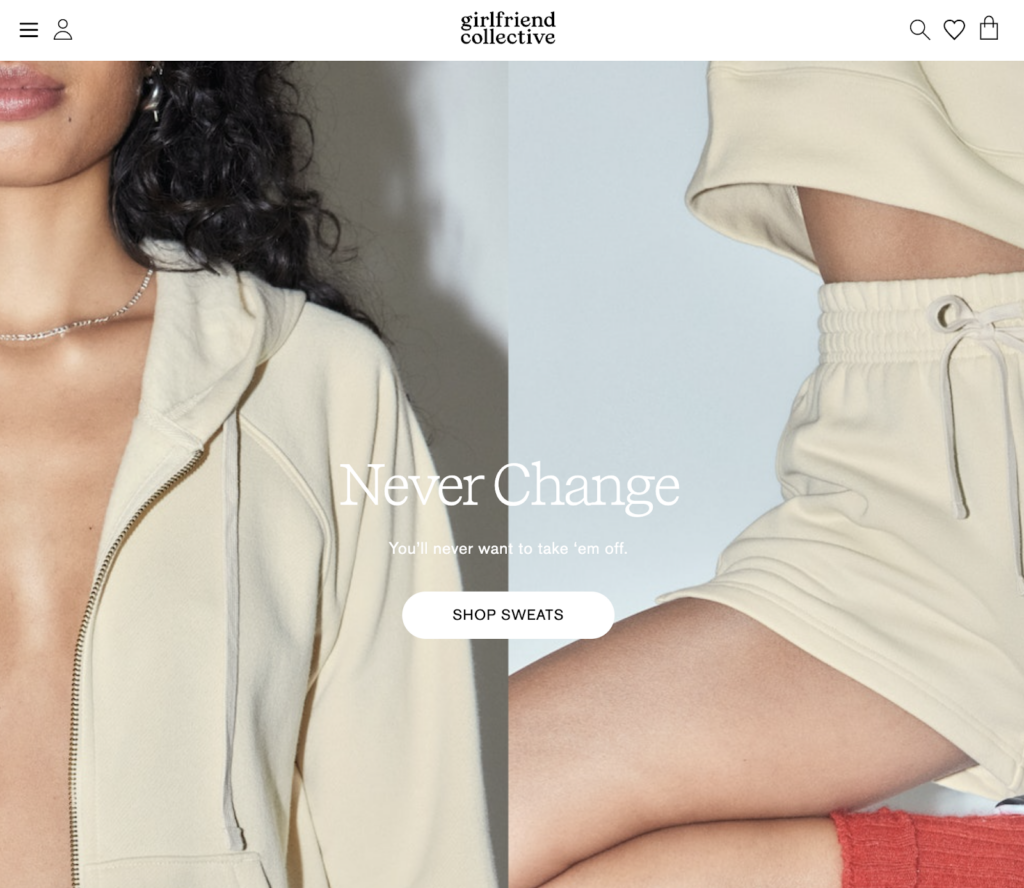
“We make everything locally in small batches to make sure we don’t have a negative impact on the environment.”
Girlfriend Collective
🌎
How do they ensure their sustainability?
Girlfriend Collective’s sustainability efforts start with using recycled and recyclable textile and packing materials. Their clothes are made from recycled materials such as post-consumer water bottles, fishing nets retrieved from the seas, fabric scraps, and other waste. On top of that, their packaging is 100% recycled and recyclable. After their clothes are dyed, all the wastewater is sent to a treatment plant 100 feet away. Treated water that meets safety standards is released into the waterway, while mud dye is donated to a pavement facility to be turned into paving stones. Additionally, they help prevent microfiber release with a branded microfiber filter. Their program “Recycle. Reuse. Regirlfriend.” collects old Girlfriend Collective compressive leggings and upcycles them into new pieces that can be worn again and again, reducing waste while moving toward a more circular fashion model. Lastly, Girlfriend Collective partners with EcoCart to provide a carbon-neutral option for all orders placed on their site to offset the carbon footprint of their products.
🌐
How do they ensure their ethics?
Girlfriend Collective’s facilities are fully certified by Social Accountability International – SA8000. An SA8000 certification guarantees safe working conditions, the right to unionize, and no forced or child labor. They also ensure all workers in their supply chain are paid fair wages and provided with free lunches and guided exercise breaks.
🤝
Are they part of any giving-back programs?
Girlfriend Collective is not known to be part of any giving-back programs.
🛍️
What is their product range?
- Best for: womenswear
- Product range: dresses, hoodies, sweatshirts, activewear, sportswear, maternity wear, tops, blouses, T-shirts, stockings, tights, shorts, lingerie, plus-size
- Price range: $$$
- Size range: 2XS–6XL
Finisterre: Ocean-Inspired Sustainable Outdoor Gear Made Ethically

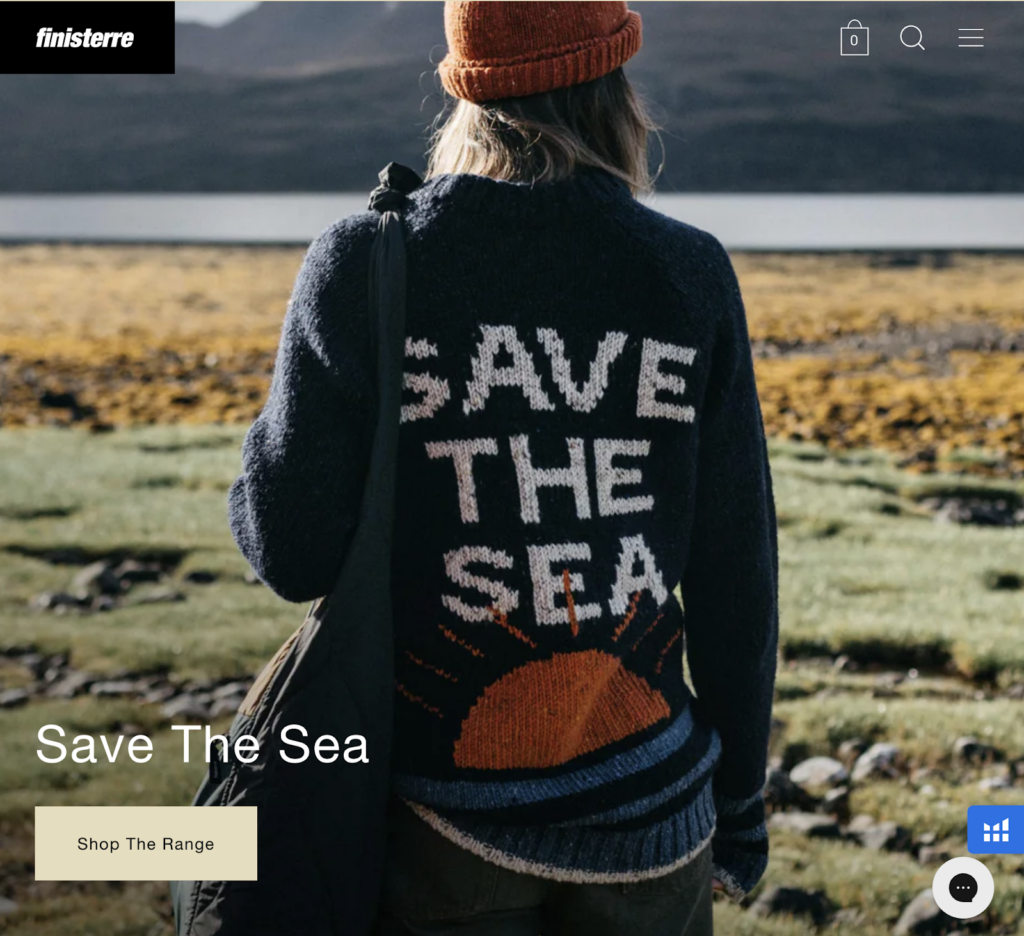
“Yet from our cliff top workshop, we stay true to our original design ethos of functionality and sustainability, remaining committed to product, environment and people.”
Tom Kay, Founder of Finisterre
🌎
How do they ensure their sustainability?
Finisterre places circular sourcing at the center of their sustainability commitment. They use renewable and recyclable textiles and biodegradable natural fibers and finishes. At least 50% of their clothes are made using recycled fabrics. For example, in 2022, 87% of the synthetic polymer fabrics used in Finisterre clothes were made using recycled fabrics, including polyester recovered from post-consumer and post-industrial waste. They also use low-impact natural fibers, including GOTS-certified organic cotton, hemp, linen, and bamboo. In 2019, they replaced all plastic packaging with water-soluble, ocean-safe, and biodegradable “Leave No Trace” garment bags. Finisterre strives to reduce textile waste by offering repair services and giving in-store credits for gear trades-in, which would be reconditioned for resale. They also implement various incentives to reduce their carbon footprint, including switching more of their stores and offices to renewable energy tariffs and transporting products using less carbon-intensive modes on land and sea. Last but not least, Finisterre is a B Corporation.
🌐
How do they ensure their ethics?
Finisterre is committed to full transparency in their supply chain, holding their partners to the high standards in their Code of Conduct and their Anti-Slavery & Trafficking Policy. Additionally, they partner with Fair Working Conditions (FWC), enabling the mapping of their supply chain, the screening of suppliers, and targeted audits at high-risk locations. Their facilities are also listed on Open Supply Hub. Lastly, Finisterre’s ethical values extend to their dedication to saving the sea. For example, they provide a free resource to inspire ocean activism.
🤝
Are they part of any giving-back programs?
Finisterre provides financial support to various giving-back campaigns and programs through the Finisterre Foundation, championing ocean access for all. For example, Finisterre turned 2021’s Black Friday into Blue Friday, where they swapped discounts for donations, raising funds for The Wetsuit Project, which adapts wetsuits for children and adults with various disabilities to access the sea. In 2022, Blue Friday was used again to raise money supporting Level Water to provide specialist swimming lessons for children with disabilities. Other projects include The Seasuit Project, City Kids Surfing, Seasuit Donation, and Art Auctioning for Good.
🛍️
What is their product range?
- Best for: menswear, womenswear
- Product range: shirts, pants, tops, sweaters, dresses, hoodies, shorts, denim, swimwear, jackets, blazers, sweatshirts, t-shirts, base layers, socks, shorts,
- Price range: $$
- Size range: XS–XXL
Wolven: Multifunctional Activewear Made From Recycled Bottles


“Sustainability to us means every decision we make is rooted in our intention to protect our planet and create a more equitable and Earth-centered future for all.”
Amanda Lapham, Co-founder of Wolven
🌎
How do they ensure their sustainability?
Wolven ensures their sustainability by sourcing a high proportion of low-impact fabrics. Specifically, all of their 2022 swimwear and activewear was made with 84% recycled polyester fabrics reclaimed from discarded plastic water bottles. Their recycled fabrics are certified with the Global Recycled Standard and OEKO-TEX® STANDARD 100. Additionally, they design their clothes to be reversible and multifunctional so consumers can do more and buy less. Regarding their climate impact, Wolven is certified Climate Neutral for reducing and offsetting their carbon emissions. They also reduce their impact by using emission-free renewable energy in the supply chain and at their office, opting for sea freight shipping over air freight, and recycling packaging materials to reduce waste. Regarding the necessary emissions, they compensate by investing in projects in wind energy and reforestation. Lastly, they further their commitment to circular fashion beyond using recycled material with their resale program, Wolven Pre-Loved.
🌐
How do they ensure their ethics?
Wolven only traces part of their supply chain. Their manufacturing partner is based in China and assessed by Intertek as conforming to the requirements of the Workplace Conditions Assessment.
🤝
Are they part of any giving-back programs?
Wolven gives back 1% of their annual revenue to nonprofit organizations. For example, each purchase from their Neutral Collection gives back to Climate Neutral through their 1% for the Planet membership. They also partner with CleanHub to organize events to pick up plastic bottles and clean up places like beaches, rivers, and canals.
🛍️
What is their product range?
- Best for: womenswear, menswear
- Product range: one-piece swimwear, bikinis, tops, tees, sweatshirts, leggings, flares, shorts, joggers
- Price range: $$
- Size range: XS–XL
VAUDE: Outdoor Gear and Activewear Where Performance Meets Ecology

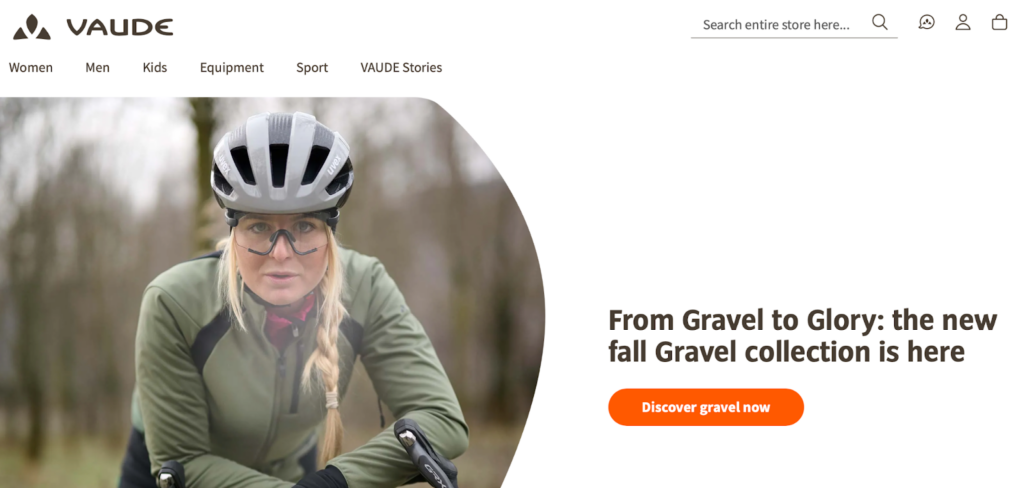
“We design with a focus on minimal material consumption, try to avoid waste and design products that are timeless, durable and repairable.”
VAUDE
🌎
How do they ensure their sustainability?
VAUDE prioritizes sustainability by creating a counterbalance to resource-consuming lifestyles. They achieve that by making durable and versatile products for life, minimizing waste during manufacturing, and enabling longer product lifespan with maintaining, repairing, donating, and upcycling guidance. VAUDE opts for materials that combine technical performance and ecological responsibility. An example of this is their use of merino wool, a natural fiber suitable for a warm and water-repellent protective layer that is ideal for mountain sports. Meanwhile, they lower the impact of this fabric by adhering to the Responsible Wool Standard and the Global Organic Textile Standard for virgin organic wool and increasing the content of GRS-certified recycled wool in their collection. Furthermore, their products have been certified by Bluesign® and Green Button. Regarding their impact, the brand sets science-based climate goals to reduce global emissions as quickly as possible, aligning with the Paris Agreement’s 1.5 degrees in global warming, and is on track with their target as of October 2022, according to Science Based Targets (SBTi). They achieved that by measuring the total carbon footprint and implementing reduction measures in hotspots like material, energy, and transport. Since the beginning of 2022, VAUDE has been a carbon-neutral company, achieved through fully offsetting their global greenhouse gas emissions in the My Climate’s climate change mitigation project in Vietnam, their most important country of production.
🌐
How do they ensure their ethics?
VAUDE ensures ethical practices for both humans and animals involved in their operation. They work with the Fair Wear Foundation to monitor their final stage of production, ensuring safe working conditions and fair wages for factory workers. They also audit 100% of their producers in high-risk countries. Additionally, VAUDE has a basic policy to support diversity and inclusion in their direct operations and supply chain. Regarding animal rights, they follow the Responsible Wool Standard, appropriately addressing sheep’s welfare and the land they graze on.
🤝
Are they part of any giving-back programs?
VAUDE donates FairWertung the products that can’t be repaired but are still perfectly functional. In 2021, VAUDE donated products with a merchandise value of approximately €339,000 (approximately $375,000 USD) to the network, which makes clothes affordable via charity shops or second-hand stores.
🛍️
What is their product range?
- Best for: sportswear (cycling, hiking, skiing) and urban outdoor clothes for women, men, and kids
- Product range: jackets, hoodies, sweaters, shirts, vests, pants, shorts, skirts, functional underwear
- Price range: $$$
- Size range: XS–XXXL
Tripulse: Activewear Made Sustainable With Certified Eucalyptus Wood Fiber


“Sustainability is at the heart of everything we do and of every decision we make. It’s part of our DNA.”
Franziska Mesche, Founder of Tripulse
🌎
How do they ensure their sustainability?
Tripulse ensures sustainability by sourcing low-impact materials, reducing waste, and overcompensating their carbon emission to be climate-positive. Firstly, they use a high proportion of TENCELTM lyocell made with certified eucalyptus wood fibers. Tripulse also opts for ROICA™ V550, a more eco-friendly stretch alternative to spandex (elastane), for the stretch element necessary in gym leggings. Furthermore, the elastane found in a small percentage of Tripulse’s Power III fabric blend consumes less energy, requires lower CO2 emissions than conventional elastane, and has various sustainability certifications (Bluesign®, OEKO-TEX®, and REACH). On top of that, they use organic cotton and natural rubber for elements lik ecare labels and waistbands. Secondly, Tripulse reduces waste by designing timeless, versatile, and multifunctional garments that are durable and long-lasting, using recycled and recyclable packaging materials, and keeping clothing with minor blemishes, prototypes, or returned and refreshed clothing in circulation with their ZeroWaste Shop. Last but not least, the brand holds climate action at the center of their operation, measuring, reducing, offsetting, and overcompensating their carbon emissions. On top of using low-carbon materials and reducing waste, they offset more than their emissions in projects preventing deforestation in biodiverse areas.
🌐
How do they ensure their ethics?
Tripulse ensures their ethics by partnering with a factory certified by the Global Organic Textile Standards and paying a living wage in the final stage of their production. They are also transparent about the rest of their supply chain, publicly sharing their suppliers for various components.
🤝
Are they part of any giving-back programs?
Tripulse plants a tree for every product purchased via their partnership with One Tree Planted.
🛍️
What is their product range?
- Best for: womenswear
- Product range: leggings, tops, T-shirts, tank tops
- Price range: $$$
- Size range: XXS–3XL
Iron Roots: Natural Athletic Apparel
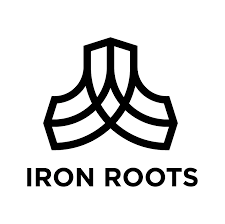
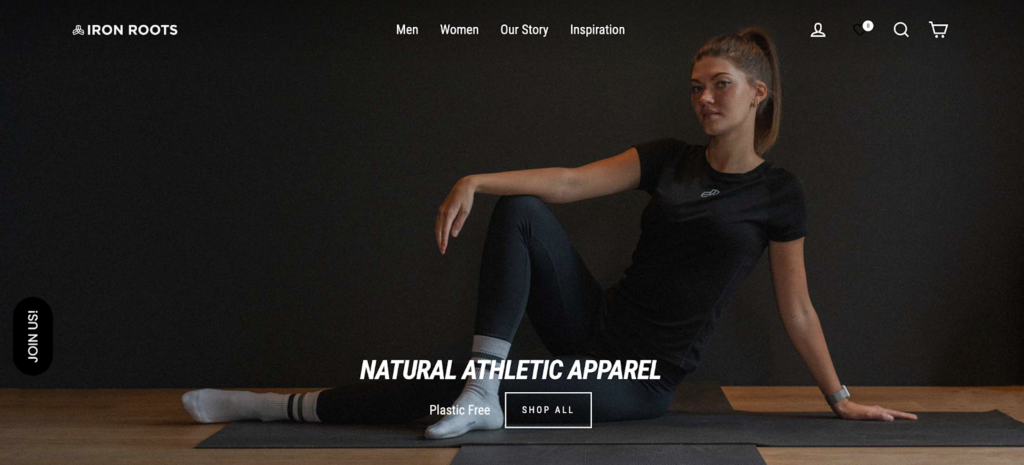
“By combining design, functionality and sustainability, we aim to create the best sportswear.”
Iron Roots
🌎
How do they ensure their sustainability?
Iron Roots prioritizes sustainability by using eco-friendly plant-based textiles, cutting down textile waste, and reducing carbon footprint. Firstly, they source a high proportion of low-impact textiles, including GOTS-certified cotton, hemp, and lyocell (Lenzing‘s TENCEL™ fibers)—three of the most sustainable fabrics. Additionally, all their healthy sportswear is tested for harmful chemicals through OEKO-TEX® certifications. Secondly, Iron Roots minimizes textile waste in multiple ways, such as designing a product from a single fabric, maximizing cutting efficiency, and sometimes using the same fabric for various products. On top of that, they offer a take-back program where customers can return their worn-out Iron Roots apparel for the purpose of recycling it into new products. Lastly, to avoid overproduction, they do not offer seasonal collections. Regarding their carbon footprint, Iron Roots manufactures locally to reduce their transporting carbon emissions and offset all those occurring from shipping in their supply chain.
🌐
How do they ensure their ethics?
Iron Roots traces most of their supply chain. The manufacturing stage happens in GOTS and SMETA-certified factories in Greece, North Macedonia, and Portugal. The factory’s workers are paid living wages that average 1.5–1.7 times the minimum wage in their country.
🤝
Are they part of any giving-back programs?
Iron Roots donates 50% of the profits from the Iron Roots x Sea Shepherd Wood T-shirt sale to Sea Shepherd, helping to protect the oceans.
🛍️
What is their product range?
- Best for: womenswear, menswear
- Product range: activewear, sportswear, hoodies, sweatshirts, accessories
- Price range: $$$
- Size range: XS–XXL
Outerknown: Stylish Clothes Made Sustainably and Ethically

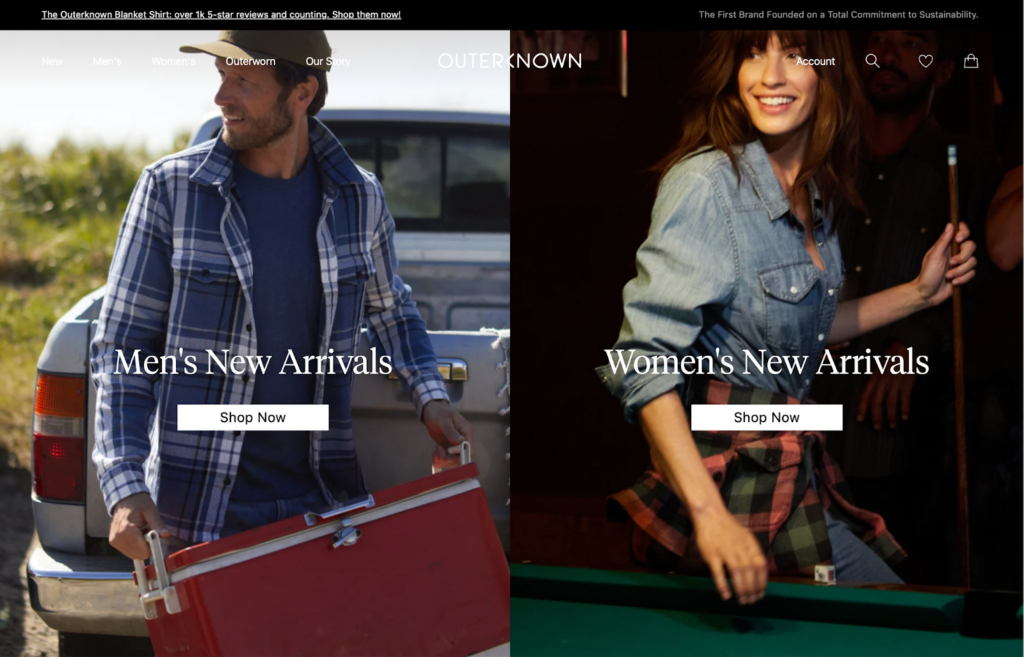
“We are driven by a passion for responsible action, courageous change, and great clothes.”
Outerknown
🌎
How do they ensure their sustainability?
Outerknown places sustainability at their core by using eco-friendly materials such as hemp, organic cotton, recycled cotton, and responsible wool in their clothing, reducing the environmental impact. In 2022, these preferred fibers accounted for 95% of their collection. The brand’s Outerworn platform offers customers a chance to buy and sell pre-loved pieces, contributing to closing the loop in fashion. They also partner with Project Vermont to give new purpose to materials that would otherwise end up in landfills. Additionally, Outerknown strives to reduce their footprint by working with two B Corp Certified suppliers and having 8 facilities running on renewable energy.
🌐
How do they ensure their ethics?
Outerknown maintains ethics by promoting the highest labor standards in alignment with the Fair Labor Association. They publicly share their Code of Conduct, which covers all of the ILO Four Fundamental Freedoms principles. Outerknown provides Fairtrade Premium, which has improved workers’ livelihoods in their supply chain via workers’ chosen programs in healthcare, education, accommodation, and financial independence.
🤝
Are they part of any giving-back programs?
Outerknown gives back to non-profits that align with their values and help make a larger impact. They work with organizations like Brother Benno, The Ocean Cleanup, Ocean Conservancy, Surfrider Maui Chapter, Surfrider Foundation, and Everytown.
🛍️
What is their product range?
- Best for: menswear, womenswear
- Product range: shirts, pants, T-shirts, tops, sweaters, dresses, hoodies, shorts, denim, jackets, blazers, jumpsuits, playsuits, swimwear
- Price range: $$$
- Size range: XS–XL
NATASHA TONIC: Making Plant-Based Swimwear to Reduce Microplastic Pollution
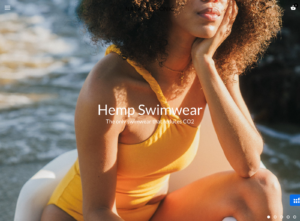
“We make everything locally in small batches to make sure we don’t have a negative impact on the environment.”
NATASHA TONIC
🌎
How do they ensure their sustainability?
NATASHA TONIC prioritizes sustainability through eco-friendly materials, low-impact processes, and low-footprint practices. They use a high proportion of sustainable natural fabrics, including hemp and certified organic cotton, and only low-impact, non-toxic dyes that contain soluble natural components and no heavy metals. Furthermore, NATASHA TONIC lowers the manufacturing impact by applying on-site heat reclamation, on-site water filtration, and no-salt-added dye baths in their dyeing processes and using biopolishing in their finishing treatments. Additionally, they reduce their transporting carbon footprint by purchasing fabrics locally in the US and using electric vehicles for delivering between suppliers and studios.
🌐
How do they ensure their ethics?
NATASHA TONIC puts protecting workers and nature at the core of their operations. As such, they trace most of their supply chain, including all of the second and final stages of production. Their second stage of production is audited by the Fair Wear Foundation. Workers at their US factory are all paid according to California standards. NATASHA TONIC also protects nature by eliminating contaminants in surface runoff to maintain the surface and groundwater quality and replacing insecticides with natural pest-controlling methods.
🤝
Are they part of any giving-back programs?
NATASHA TONIC donates 5% of every swimsuit sold to 5 Gyres to support fighting plastic and microfibre pollution. Additionally, they contribute to the cause of social movements, including Tree People, Black Lives Matter, and Downtown Women’s Center.
🛍️
What is their product range?
- Best for: womenswear
- Product range: swimwear, tops, blouses, bodysuits, lingerie
- Price range: $$$
- Size range: XS–XL
Definite Articles: For Active People Who Love Their Planet


“Our fabric is not only rigorously tested and certified free of forever chemicals like BPA and PFAS, but it is also infused with an innovative technology called CiCLO that significantly accelerates the biodegradation of the garment once discarded, transforming it naturally into soil in just a few years.”
Definite Articles
🌎
How do they ensure their sustainability?
Definite Articles ensures their sustainability firstly by creating the planet’s first biodegradable performance wear to reduce plastic waste and associated pollution. In particular, they use the next generation, OEKO-TEX® certified sustainable technology “CiCLO” that enables traditional yarns like nylon and polyester to behave like natural fibers when they end up in the environment and thus biodegrade in two to three years rather than centuries. Additionally, their collection is free of harmful chemicals like BPA and PFAS and partly made with relatively low-impact textiles such as cotton under the Better Cotton Initiative or lyocell. Secondly, Definite Articles reduces their climate impact by keeping their entire supply chain locally in the US for a lower transporting carbon footprint. They also opt to pack their orders in carbon-neutral fulfillment centers.
🌐
How do they ensure their ethics?
Definite Articles ensure their ethics by sourcing their fabrics from family-owned mills. Their Supplier Code of Conduct covers ILO’s Fundamental Principles and Rights at Work.
🤝
Are they part of any giving-back programs?
Definite Articles gives back by planting trees in the US. They are a reforestation partner of One Tree Planted, committing to donations of 2% their annual revenue.
🛍️
What is their product range?
- Best for: womenswear, menswear, kidswear
- Product range: leggings, sports bras, tanks, joggers, hoodies, shorts, shirts, socks
- Price range: $$
- Size range: XS–XL
Vitamin A: Swimwear and Beachwear Made Sustainably With Recycled Nylon


“We focus on the intersection of flawless fit, high quality, continuous innovation, and elegant designs… Every one of our pieces is designed by women, for women.” Amahlia Stevens, founder of
Vitamin A
🌎
How do they ensure their sustainability?
Vitamin A ensures their sustainability by sourcing recycled synthetic materials for their products and manufacturing them locally using low-impact technologies. They use recycled nylon in place of virgin nylon to create fabric blends for their bikinis, swimsuits, and beachwear lines, saving 77% water usage. The brand also incorporates sustainable natural fabrics and high-performing plant-based textiles into their products, including GOTS-certified organic cotton, linen, recycled cotton, and TENCEL™. All materials used by Vitamin A are certified to meet the global OEKO-TEX® STANDARD 100 for safe textiles. On top of that, the majority of their swimwear is crafted locally in Californian vertically integrated facilities (and the rest in the US), reducing the transporting carbon footprint. Regarding production, they use mostly digital printing, which requires less water and creates less fabric waste than traditional wet printing. Other measures used at their headquarters and warehouse to reduce their environmental footprint include all paper products made with 100% recycled post-consumer waste, no disposable plastic water bottles, a heat reclamation system, and working-from-home support to avoid unnecessary travel.
🌐
How do they ensure their ethics?
Vitamin A ensures their ethical and responsible production by keeping production locally in California, which has the strictest environmental laws in the nation. They also visit their factories regularly to ensure employees are being treated and paid fairly and that the working conditions are clean and safe.
🤝
Are they part of any giving-back programs?
Vitamin A is a proud member of 1% for the Planet. They give back to organizations that work to protect the oceans. Additionally, they host beach cleanups.
🛍️
What is their product range?
- Best for: womenswear
- Product range: swim tops, swim bottoms, beach tops, beach bottoms, one-pieces, dresses, rompers, shirts, pants, overalls, hoodies, shorts, accessories
- Price range: $$
- Size range: XS–XXL
Elle Evans: Swimwear Made to Order From Circular Regenerated Nylon


“I knew I wanted to structure my company differently, and starting from scratch meant that sustainability could be at the heart of every decision I made.”
Elle Evans, founder of Elle Evans
🌎
How do they ensure their sustainability?
Elle Evans prioritizes sustainability by reducing the carbon footprint throughout the life-cycle of their products, from sourcing to transporting and packaging. Firstly, their fabrics have a high proportion of ECONYL® regenerated yarn from nylon waste, avoiding the high-impact virgin nylon while rescuing waste such as finishing nets from the bottom of the oceans and carpets from landfills. Further down the production line, they have their fabrics digitally printed using water-based, non-toxic inks, a process that leaves no ink discarded down drains and no washing required after printing. Afterward, the fabrics are only cut and sewn after a product is ordered to further reduce waste. The final products are wrapped in carry bags made from deadstock fabrics from Elle Evans’ studio and delivered using carbon-neutral couriers Sendle.
🌐
How do they ensure their ethics?
Elle Evans makes their products themselves in-house by the founder/owner and a small team. Regarding their materials, they trace most of their supply chain.
🤝
Are they part of any giving-back programs?
Elle Evans gives back by donating 1% of all their sales to the Healthy Seas Initiative, supporting their mission to protect and advocate for the seas.
🛍️
What is their product range?
- Best for: womenswear, kidswear
- Product range: swimwear, tops, blouses, shorts, hats, accessories, plus-size
- Price range: $$
- Size range: XXS–XXXL
ARMEDANGELS: Sustainable Clothing Brand Plus an Agent of Lifestyle Change

“So starting out with the humble tee, we took our oath against wage slavery, chemical shortcuts, and mass-producing pure crap, and transformed ourselves into one of the first clothing brands in all the land to put people and planet first.”
ARMEDANGELS
🌎
How do they ensure their sustainability?
ARMEDANGELS ensures sustainability by reducing carbon footprints while enabling people to change lifestyles to fight climate change. The brand innovates to cut down carbon emissions in their supply chain, starting with sourcing a high proportion of eco-friendly materials. Specifically, they use GOTS-certified organic cotton fabrics, GRS-certified recycled fabrics, GOTS-and RWS-certified organic wool fabrics, and FSC/PEFC-certified wood-based fabrics like TENCELTM Modal. Additionally, ARMEDANGELS chooses materials with the lowest carbon footprint possible, for example, opting for modal and lyocell over silk or natural fabrics over fossil-based synthetic fabrics while increasing recycled content, such as recycled wool and recycled cotton. For example, within a year, the share of recycled cotton in their DetoxDenim jeans increased from 5% to 37%, with some jeans in the collection containing 100% recycled cotton. Lastly, ARMEDANGELS’s efforts to encourage lifestyle change include care and repair guides to keep garments longer in circulation. They also have a resale platform that facilitates traded-in items to be sold again as second-hand clothes or recycled as fibers for new clothes.
🌐
How do they ensure their ethics?
ARMEDANGELS ensures their ethics by only working with trusted partners to deliver decent wages and workers’ safety. They directly and actively monitor all their suppliers and the suppliers’ nominated subcontractors via on-site and online Internal Due Diligence Check and Self-Assessment, external audits by Fair Wear Foundation (FWF), Global Organic Textile Standard and third-party audits, continuous support, and tailored training programs by third parties. ARMEDANGELS ensures payment of a living wage in part of their supply chain and pays a markup where they notice wage issues via the living wage project. Most importantly, they are fully transparent about the journey from raw material to their products, especially where people and animals are involved, and the impacts of their actions.
🤝
Are they part of any giving-back programs?
ARMEDANGELS raises funds by donating part of their sales to support various organizations and campaigns. For example, during the COVID-19 pandemic, they raised €745.800 ($790,883.61 USD) for Doctors Without Borders, facilitating isolation wards, COVID-19 clinics, and protective clothing for medical professionals worldwide. Other fundraising projects include supporting the climate movement with German Zero and the Climate Emergency Fund, fighting for equality with UN Women, advocating for fair payment and safe working conditions for Bangladeshi garment workers with the National Garment Workers Federation, and rescuing refugees in the Mediterranean Sea with Sea-Watch.
🛍️
What is their product range?
- Best for: kidswear, menswear
- Product range: denim jeans, jackets, jumpsuits, shorts, skirts, T-shirts
- Price range: $$
- Size range: XS–XXL
Happy Earth Apparel: Earth-First Organic Clothing Brand


“We’re not cool with compromise when it’s at the expense of our world. We’ll find a good way to do something, or we won’t do it.”
Happy Earth Apparel
🌎
How do they ensure their sustainability?
Happy Earth Apparel ensures sustainability by sourcing sustainable and organic textile materials, using recycled and recyclable packaging, and reducing waste. Firstly, Happy Earth Apparel uses a high proportion of organic cotton. For example, their organic sock collection is made with organic cotton that uses a small percentage of recycled nylon and elastane to enhance flexibility and moisture-wicking performance. Secondly, they use 100% post-consumer, recycled plastic to make durable packaging bags that can be recycled again. Also, these bags are lightweight, cutting down on transporting emissions and costs. Lastly, Happy Earth Apparel has waste-reduction incentives regarding plastic (shipping in bulk), water (wastewater recycling and rain harvesting), and textile (low-waste cutting techniques). Furthermore, Happy Earth Apparel is Climate Neutral Certified for reducing and offsetting their emissions. They also use solar energy in their supply chain to reduce their carbon emissions. Regarding emissions that can’t be avoided, they offset through clean energy projects in the US, Uganda, India, and China. These include providing energy-efficient stoves, capturing methane, and installing biodigesters in rural homes that convert manure waste into gas for cooking.
🌐
How do they ensure their ethics?
Happy Earth Apparel ensures their ethics by binding suppliers with a Code of Conduct covering four of ILO’s Fundamental Principles and Rights at Work. Additionally, over 95% of their products are made in Fairtrade-certified factories, while part of their final production stage is certified by Worldwide Responsible Accredited Production (WRAP). Finally, Happy Earth Apparel traces most of their supply chain.
🤝
Are they part of any giving-back programs?
Happy Earth Apparel actively participates in giving-back programs. As a member of 1% for the Planet, Happy Earth Apparel is committed to donating a minimum of 1% of their revenue to charitable organizations through their Tree Planting, Climate Change, and Trash Clean-Up projects. For example, consumers can choose to plant five trees for every purchase.
🛍️
What is their product range?
- Best for: womenswear, menswear
- Product range: shirts, T-shirts, sweatshirts, hoodies, jackets, bottoms, dresses, pants, leggings, shorts, socks, accessories
- Price range: $$
- Size range: XXS–XXL
Threads 4 Thought: Everyday Basics Produced Responsibly
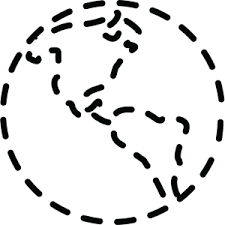
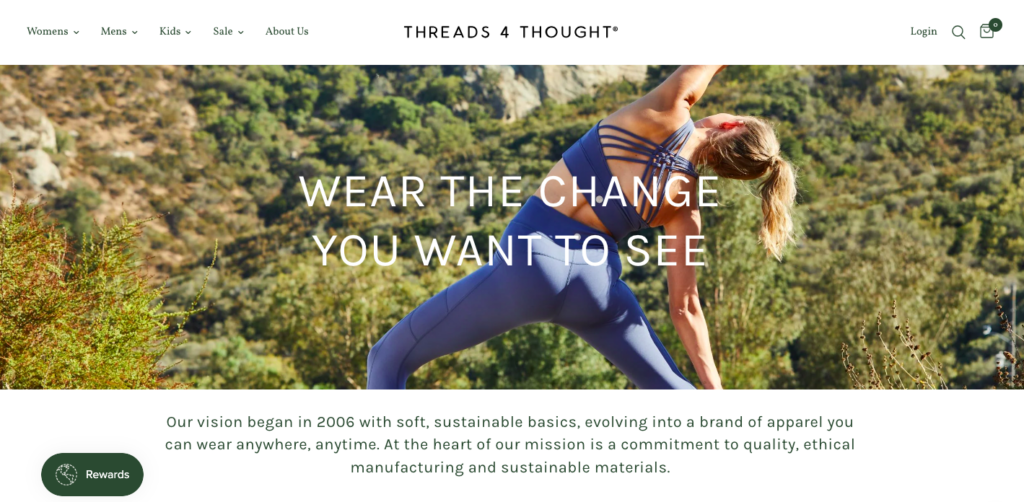
“From our original designs to our fabrics to the factory floor, we are committed to leaving an innately smaller impact on our planet.”
Threads 4 Thought
🌎
How do they ensure their sustainability?
Threads 4 Thought promotes sustainability by sourcing a high proportion of eco-friendly materials,including recycled polyester, organic cotton, and modal with Lenzing’s renewable beech tree pulp. For example, the Lunette Sports Bra contains 88% recycled polyester. Further down the life-cycle in manufacturing, they lower their environmental impacts by implementing a dye technology that eliminates all harmful chemicals and reduces water usage during the dyeing process by 95%. They also recycle 80% of their main factory’s industrial wastewater. Additionally, their packing materials are fully FSC-certified, with 90% being WaveBags, which are 100% recyclable, water resistant, and strong. Lastly, 99% of their products are transported by boat rather than air, reducing carbon emissions during the transportation stage.
🌐
How do they ensure their ethics?
Threads 4 Thought traces most of their supply chain and reduces their impact through Greenstory. They have a Supplier Code of Conduct that covers all ILO’s Fundamental Freedoms.
🤝
Are they part of any giving-back programs?
Threads 4 Thought partners with the International Rescue Committee to help people displaced due to various conflicts.
🛍️
What is their product range?
- Best for: menswear, womenswear, kidswear
- Product range: sweaters, dresses, pants, jackets, blazers, shorts, hoodies, sweatshirts, T-shirts, tops, blouses, maternity wear, stockings, tights, jumpsuits, playsuits, sportswear, sleepwear, accessories, plus-size
- Price range: $$
- Size range: XS–XXL
Why Is It Important to Buy Products Made of More Sustainable Fabrics
It is important to buy products made of more sustainable fabrics because a sustainable textile industry has a lower carbon footprint, helps save natural resources, and is better for forests, animals, and humans.
Buying Sustainable Fabrics Reduces Your Carbon Footprint
The production of clothing and footwear is estimated to contribute 10% of global greenhouse gas emissions—more than all international flights and shipping combined. If the fashion industry were a country, it would be the fourth largest emitter of carbon dioxide.
One way to reduce the carbon footprint of the clothes you buy is to opt for sustainable fabrics. Sustainable fabrics, which are often made with natural or recycled fibers, have relatively low carbon footprints compared to petroleum-based fabrics. For example, organic cotton made in the US has a carbon footprint of 2.35 kg CO2 (per ton of spun fiber)—a quarter of polyester’s carbon footprint.
Buying Sustainable Fabrics Reduces Demand For Natural Resources and Waste Management
The textile industry uses water and land to grow cotton and other fibers. It is estimated that 79 billion cubic meters of water were used for the sector worldwide in 2015. For example, producing a single cotton t-shirt requires as much water as one person drinks for 2.5 years (2,700 liters of fresh water).
Worse yet, the textile economy is vastly more linear than circular: the largest amount of resources used in clothes ended up in landfills (instead of being recycled to remake clothes). According to a report by the Ellen MacArthur Foundation,
- Less than 3% of materials used in the textile economy in 2015 came from recycled sources.
- In other words, more than 97% of resources used in making clothes are newly extracted.
When clothing items are disposed of within a short period of time—under a year in the case of half of the fast fashion clothes—the natural systems that provide raw materials for fabrics don’t have enough time to recover and regenerate, which could lead to ecological breakdown.
Sustainable fabrics are made with less water and emissions while lasting longer:
- Because they are durable, you don’t need to buy new clothes too often.
- Thus, you help reduce the pressure to extract more resources for making new items.
Similarly, making and consuming sustainable fabrics made with recycled materials reduces the demand for virgin materials while helping tackle waste management.
Buying Sustainable Fabrics Encourages Sustainable Management of Forests
Sustainable natural fiber fabrics are made with raw materials from forests and plantations that are sustainably managed, such as complying with FSC standards.
When you buy sustainable natural fiber fabrics, you discourage unsustainable forestry practices like illegal logging. You can help reduce deforestation, biodiversity loss, and the effects of climate change.
Buying Sustainable Fabrics Encourages Fairer Treatment of Animals
The fashion industry is rife with animal mistreatment when it comes to making animal-based fabrics like wool or silk. Every year, billions of animals suffer and die for clothing and accessories.
Buying sustainable vegan alternatives can help to reduce the pressure on raising more and more animals to meet the demand for animal-based fabrics while sacrificing their well-being and lives.
Suppose you have to buy fabrics made with, for example, wool or silk; make sure you only choose brands committed to cruelty-free products. In that case, you help advocate better treatments for animals raised within the textile industry.
Using Sustainable Fabrics Encourages Fairer Treatment of Textile Workers
Recent statistics from UNICEF estimated as many as 170 million child laborers worldwide, many of whom were engaged in some form of work in the textile industry. They don’t get paid minimum wages and often work long hours.
When you buy sustainable fabrics from brands transparent about the working conditions at their factories, you discourage the use of child labor and help promote better working conditions for textile workers.
How Can You Generally Buy More Sustainable Fabrics
The key to sustainably buying fabrics is to check on relevant environmental and original certifications.
For natural fabrics:
- Global Organic Textile Standard (GOTS): A globally recognized certification system that ensures a certain threshold of organic content has been met. It covers manufacturing, packaging, labeling, transportation, and distribution (but not what happens in the fields where crops are grown).
- USDA Certified Biobased Product: The USDA BioPreferred® Certification is a voluntary certification offered by the United States Department of Agriculture. The certification identifies products made from plants or other renewable materials.
- Ecolabel: Ecolabel is the official European Union voluntary label recognized worldwide for certified products with a guaranteed, independently verified low environmental impact. The label requires high environmental standards throughout the entire life-cycle: from raw material extraction through production and distribution to disposal. It also encourages companies to develop innovative, durable, easy-to-repair, and recyclable products.
For natural fiber semi-natural/semi-synthetic fabrics:
- Forest Stewardship Council: An FSC certification ensures that the wood (or wood-like material) comes from responsibly managed forests that provide environmental, social, and economic benefits.
There are two types of FSC Certification:- FSC Forest Management Certification, with a focus on the origin of the wood—the forest.
- FSC Chain of Custody Certification, which focuses on the path from the forest to the customer’s home.
- Program for Endorsement of Forest Certification: PEFC’s approaches to sustainable forest management are in line with protecting the forests globally and locally and making the certificate work for everyone. Getting a PEFC certification is strict enough to ensure the sustainable management of a forest is socially just, ecologically sound, and economically viable but attainable not only by big but small forest owners.
For recycled fabrics:
- Recycled Claim Standard (RCS): The Textile Exchange RCS was originally developed as an international, voluntary standard that sets requirements for third-party certification of Recycled input and chain of custody.
- The Global Recycled Standard (GRS): The Global Recycled Standard (GRS) is an international, voluntary, full product standard that sets requirements for third-party certification of Recycled Content, chain of custody, social and environmental practices, and chemical restrictions. It can be used for any product with more than 20% recycled material.
For all types of fabrics:
- STeP by OEKO-TEX®: STeP by OEKO-TEX® is an independent certification system for brands, retailers, and manufacturers from the textile and leather industry. It communicates organizational environmental measures, including reducing carbon footprint and water usage.
- OEKO-TEX® Standard 100: OEKO-TEX® labels aim to ensure that products pose no risk to human health (i.e., containing banned chemicals).
Some certifications that are signaling brands’ efforts toward lowered environmental impacts and a circular economy are:
- B Corp Certification: The label B Corp is a certification reserved for for-profit companies. Certified holders are assessed on their social and environmental impacts.
- Cradle2Cradle certification: Cradle2Cradle provides a standardized approach to material circularity. It assesses whether products have been suitably designed and made with the circular economy in mind covering five critical categories: material health, material reuse, renewable energy and carbon management, water stewardship, and social fairness.
Final Thoughts
Activewear is a category of clothing that is often high-impact due to its frequent washing needs and its conventional use of high-impact synthetic fabrics for stretch and moisture wicking. Thus, it is important to shop with ethics and sustainability in mind when choosing your next pair of running shorts or cycling gloves.
By purchasing activewear from brands that commit to sustainability, you support their mission to create a fairer and less harmful textile industry for all lives on Earth.
Here is the list (again) of the most sustainable activewear brands:
– Patagonia
– Girlfriend Collectives
– Finisterre
– Wolven
– VAUDE
– Tripulse
– Iron Roots
– Outerknown
– NATASHA TONIC
– Definite Articles
– Vitamin A
– Elle Evans
– ARMEDANGELS
– Happy Earth Apparel
– Threads 4 Thoughts
To make your use of these clothing items even more sustainable, follow these steps:
- Buy recycled or upcycled activewear made with low-impact materials.
- Keep your activewear for as long as possible.
- At the end-of-life of your activewear, upcycle the materials to extend their usage and arrange for them to be recycled or properly disposed of.
Stay impactful,

Sources
- Science Direct: Life-cycle assessment (LCA)
- Patagonia: Home
- Girlfriend Collective: Home
- Finisterre: Home
- VAUDE: Home
- Woven: Home
- Tripulse: Home
- Iron Roots: Home
- Outerknown: Home
- NATASHA TONIC: Home
- Definite Articles: Home
- Vitamin A: Home
- Elle Evans: Home
- ARMEDANGELS: Home
- Happy Earth Apparel: Home
- Threads 4 Thought: Home
- Good On You: The Ultimate Guide to More Ethical and Sustainable Activewear
- Patagonia: The Climate Crisis Is Our Business
- Patagonia: The Climate Crisis Is Our Business | No More Virgin Petroleum Fibers by 2025
- Patagonia: The Climate Crisis Is Our Business | Is Each Product Worth the Environmental Cost?
- Patagonia: The Climate Crisis Is Our Business | Help Suppliers Cut Emissions
- Patagonia: Environmental Responsibility
- Patagonia: Regenerative Organic Certified fibers
- Patagonia: Hemp
- Patagonia: Man-made Cellulose Fibers
- Patagonia: Recycled Cotton
- Patagonia: Recycled Polyester
- Patagonia: WORN WEAR
- B Corporation: Patagonia
- Bluesign: Home
- Fair Trade: Home
- FAIR TRADE CERTIFIED: Improving Lives, Protecting the Planet.
- Patagonia: Social Responsibility
- Patagonia: Fair Trade
- Patagonia: Fair Labor Association
- Patagonia: Living Wage Program
- Patagonia: Migrant Workers Program
- Patagonia: Responsible Purchasing Practices
- Patagonia: Where We Do Business
- Patagonia: 1% for the Planet
- Forbes: Yvon Chouinard And The Patagonia Purpose Trust— What Is It And Will It Work?
- Fast Company: Patagonia uses capitalism to save the planet with the Holdfast Collective
- The New York Times: Patagonia Founder Gives Away the Company to Fight Climate Change
- Girlfriend Collective: About
- Girlfriend Collective: How is your recycled fabric made?
- Girlfriend Collective: Is everything eco-friendly?
- Girlfriend Collective: The Microfiber Filter
- Girlfriend Collective: Recycle. Reuse. Regirlfriend
- EcoCart: Home
- Girlfriend Collective: Are you carbon neutral
- Good On You: Brand Directory | Girlfriend Collective
- SA8000 Standards: Home
- Finisterre: Fabric of Finisterre
- Finisterre: Recycled Fabrics
- Impactful Ninja: How Sustainable Are Recycled Fabrics? A Life-Cycle Analysis
- Global Organic Textile Standard (GOTS): Home
- Impactful Ninja: How Sustainable Are Organic Cotton Fabrics? A Life-Cycle Analysis
- Impactful Ninja: How Sustainable Are Linen Fabrics? A Life-Cycle Analysis
- Impactful Ninja: How Sustainable Are Bamboo Fabrics? A Life-Cycle Analysis
- Finisterre: Impact Reports
- Finisterre: Repair Workshop
- Finisterre: Finisterre x RESKINNED | REPURPOSING OLD GEAR FOR NEW ADVENTURES
- Finisterre: POSITIVE IMPACT REPORT 2022
- B Corporation: Finisterre
- Finisterre: Finisterre – A Positive Impact Business
- Finisterre: Anti-Slavery and Trafficking Policy
- Fair Working Conditions (FWC): Home
- Finisterre: Factories of Finisterre
- Open Supply Hub: Home
- Finisterre: Sea7 | The Materclasses
- Finisterre Foundation CIC: Grant Making Policy
- Finisterre: Finisterre Foundation | The Wetsuit Project
- Level Water: Home
- Finisterre: Finisterre Foundation | The Seasuit Project
- Finisterre: Finisterre Foundation | City Kids Surfing
- Good On You: Brand Directory | Wolven
- Wolven: Turmeric Active Top
- Wolven: 2023 Impact Report
- Impactful Ninja: How Sustainable Are Recycled Polyester Fabrics? A Life-Cycle Analysis
- Impactful Ninja: How Sustainable Are Spandex Fabrics? A Life-Cycle Analysis
- Impactful Ninja: How Sustainable Are Elastane Fabrics? A Life-Cycle Analysis
- Impactful Ninja: How Sustainable Are Recycled Fabrics? A Life-Cycle Analysis
- Textile Exchange: Global Recycled Standard
- OEKO-TEX: OEKO-TEX STANDARD 100
- CHANGE CLIMATE: Wolven is Climate Neutral Certified
- Good On You: Brand Directory | Wolven
- Treet: Wolven Pre-Loved
- Intertek: Home
- LinkedIn: Wolven
- Wolven: Neutral Collection
- Climate Neutral: Home
- CleanHub: Home
- VAUDE: CSR Report | Produce Philosophy
- Good On You: Brand Directory | VAUDE
- VAUDE: CSR Report | Don’t wash any more than necessary
- VAUDE: CSR Report | Repair Don’t Replace
- VAUDE: CSR Report | Second-hand and donations
- VAUDE: CSR Report | Upcycling
- VAUDE: CSR Report | Material Policy
- Impactful Ninja: How Sustainable Are Merino Wool Fabrics? A Life-Cycle Analysis
- VAUDE: CSR Report | Wool
- Bluesign: Home
- Green Button: Home
- Science Based Targets (SBTi): Home
- VAUDE: CSR Report | Climate Footprint
- VAUDE: CSR Report | Climate-Neutral Business
- VAUDE: CSR Report | Our Producers
- FairWertung: Home
- CHANGE CLIMATE: Tripulse is Climate Neutral Certified
- Tripulse: Materials & Trims
- Tripulse: WE’RE CLIMATE NEUTRAL CERTIFIED FOR 2023!
- Tripulse: Climate Action
- Good On You: Brand Directory | Tripulse
- Impactful Ninja: How Sustainable Are TENCEL Fabrics? A Life-Cycle Analysis
- ASAHI KASEI: ROICA
- THE SLOW LABEL: The problem with Elastane: ROICA™ V550 is an alternative
- Impactful Ninja: How Sustainable Are Spandex Fabrics? A Life-Cycle Analysis
- Impactful Ninja: How Sustainable Are Elastane Fabrics? A Life-Cycle Analysis
- Bluesign: Home
- European Union: REACH Regulation
- Impactful Ninja: How Sustainable Are Organic Cotton Fabrics? A Life-Cycle Analysis
- Tripulse: Design Philosophy
- Tripulse: Packaging and transportation
- Tripulse: OUR WAY TO ZERO WASTE
- Tripulse: ZeroWaste Shop
- Global Organic Textile Standards: Home
- Tripulse: Ethical & transparent supply chain
- Tripulse: WHY WE PLANT TREES WITH EVERY PRODUCT PURCHASED
- One Tree Planted: Home
- Good On You: Brand Directory | Iron Roots
- Impactful Ninja: How Sustainable Are Cotton Fabrics? A Life-Cycle Analysis
- Impactful Ninja: How Sustainable Are Hemp Fabrics? A Life-Cycle Analysis
- Lenzing: Home
- Impactful Ninja: 10 Most Sustainable Fabrics: The Full Life-Cycle Analysis
- Iron Roots: Healthy Sportswear
- Iron Roots: Fair Production
- Iron Roots: FAQ
- Iron Roots: SUSTAINABILITY POLICY
- Iron Roots: Iron Roots x Sea Shepherd Wood T-shirt
- Impactful Ninja: How Sustainable Are Recycled Cotton Fabrics? A Life-Cycle Analysis
- Impactful Ninja: How Sustainable Are Wool Fabrics? A Life-Cycle Analysis
- Outerknown: Progress Every Step Of The Way
- Outerknown: What is Outerworn?
- Shopify: OUTERKNOWN Supplier Code of Conduct
- Fair Labor Association: Home
- International Labour Organization: ILO Declaration on Fundamental Principles and Rights at Work
- Fairtrade: Fairtrade Premium
- Brother Benno: Home
- The Ocean Cleanup: Home
- Ocean Conservancy: Home
- Surfrider Maui Chapter: Home
- Surfrider Foundation: Home
- Everytown: Home
- NATASHA TONIC: TRANSPARENCY
- CONTENT BEAUTY & WELLBEING: MEET THE MAKER: NATASHA TONIC SUSTAINABLE SWIMWEAR
- 5 Gyres: Home
- CONTEMPORARY FASHION: CHANGING WOMEN’S SWIMWEAR
- B Corporation: Definite Articles
- Definite Articles: Sustainability
- OEKO-TEX: Home
- Impactful Ninja: How Sustainable Are Nylon Fabrics? A Life-Cycle Analysis
- Impactful Ninja: How Sustainable Are Polyester Fabrics? A Life-Cycle Analysis
- Impactful Ninja: How Sustainable Are Lyocell Fabrics? A Life-Cycle Analysis
- Definite Articles: Supplier Code of Conduct
- International Labor Organization (ILO): Fundamental Principles and Rights at Work
- Impactful Ninja: How Sustainable Are Recycled Nylon Fabrics? A Life-Cycle Analysis
- Impactful Ninja: How Sustainable Are Nylon Fabrics? A Life-Cycle Analysis
- Vitamin A: Fabrics
- Impactful Ninja: How Sustainable Are TENCEL™ Fabrics? A Life-Cycle Analysis
- Vitamin A: Sustainability
- 1% for the Planet: Home
- Vitamin A: About
- Good On You: Brand Directory | Elle Evans
- Econyl: Home
- Elle Evans: Steps in Sustainability
- Sendle: Home
- Healthy Seas: Home
- ARMEDANGELS: Activewear
- Good On You: Brand Directory | ARMEDANGELS
- ARMEDANGELS: THE JOURNEY FROM RAW MATERIAL TO PRODUCT | A T-Shirt Made from Organic Cotton
- Impactful Ninja: How Sustainable Are Organic Cotton Fabrics? A Life-Cycle Analysis
- Impactful Ninja: How Sustainable Are Recycled Fabrics? A Life-Cycle Analysis
- Global Organic Textile Standard (GOTS): Home
- Impactful Ninja: How Sustainable Are Organic Wool Fabrics? A Life-Cycle Analysis
- Forest Stewardship Council: Home
- Programme for the Endorsement of Forest Certification: Home
- Impactful Ninja: How Sustainable Are Wood-Based Fabrics? A Life-Cycle Analysis
- ARMEDANGELS: THE JOURNEY FROM RAW MATERIAL TO PRODUCT | Recycling
- ARMEDANGELS: About Us
- Impactful Ninja: How Sustainable Are Silk Fabrics? A Life-Cycle Analysis
- Impactful Ninja: How Sustainable Are Natural Fabrics? A Life-Cycle Analysis
- Impactful Ninja: How Sustainable Are Synthetic Fabrics? A Life-Cycle Analysis
- Impactful Ninja: How Sustainable Are Recycled Wool Fabrics? A Life-Cycle Analysis
- Impactful Ninja: How Sustainable Are Recycled Cotton Fabrics? A Life-Cycle Analysis
- ARMEDANGELS: DETOX DENIM
- ARMEDANGELS: Care Guide
- ARMEDANGELS: Repair Guide
- ARMEDANGELS: RETURN YOUR OLD CLOTHES | RECYCLING WITH BENEFITS
- ARMEDANGELS: ACTION REPORT 2021
- Fair Wear Foundation: Home
- ARMEDANGELS: LIVING WAGE PROJECT
- ARMEDANGELS: Collaborations
- Doctors Without Borders: Home
- German Zero: Home
- Climate Emergency Fund: Home
- Happy Earth Apparel: PlantTecTM activewear
- B Corporation: Happy Earth Apparel
- Happy Earth Apparel: About Us
- Good On You: Brand Directory | Happy Earth Apparel
- Happy Earth Apparel: Organic socks
- Impactful Ninja: How Sustainable Are Elastane Fabrics? A Life-Cycle Analysis
- Change Climate: Happy Earth LLC | A Climate Neutral Certified Brand
- Happy Earth Apparel: Supporting Carbon Emissions Reduction
- Happy Earth Apparel: Code of Conduct
- International Labor Organization (ILO): Fundamental Principles and Rights at Work
- Worldwide Responsible Accredited Production: Home
- Happy Earth Apparel: Tree Planting
- Good On You: Brand Directory | Threads 4 Thought
- Threads 4 Thought: Lunette Sports Bra
- Threads 4 Thought: Materials
- Threads 4 Thought: Ethical Manufacturing
- WaveBags: Home
- Threads 4 Thought: About Threads 4 Thought
- Greenstory: Home
- International Rescue Committee: Home
- NEWSWIRE: Threads for Thought Donates $200,000 to the International Rescue Committee
- European Parliament: The impact of textile production and waste on the environment (infographic)
- Science Direct: The challenge of “Depeche Mode” in the fashion industry – Does the industry have the capacity to become sustainable through circular economic principles, a scoping review
- Science Direct: Carbon Footprint of Textile and Clothing Products
- European Parliament: Environmental impact of the textile and clothing industry
- European Parliament: What if fashion were good for the planet?
- Ellen MacArthur Foundation: A New Textiles Economy: Redesigning fashion’s future
- McKinsey: Style that’s sustainable: A new fast-fashion formula
- Forest Stewardship Council: Home
- Our World in Data: Deforestation and Forest Loss
- Our World in Data: Renewable Energy
- Peta: Animals Used For Clothing
- The Guardian: Child labour in the fashion supply chain
- Impactful Ninja: How Sustainable Are Natural Fabrics? A Life-Cycle Analysis
- Global Organic Textile Standard (GOTS): Home
- BioPreferred: WHAT IS THE BIOPREFERRED PROGRAM?
- European Commission: Environment | EU Ecolabel
- Impactful Ninja: How Sustainable Are Semi-Natural/Semi-Synthetic Fabrics? A Life-Cycle Analysis
- Forest Stewardship Council
- FSC Forest Management Certification
- FSC Chain of Custody Certification
- Textile Exchange: The RCS and GRS are designed to boost the use of recycled materials
- Program for Endorsement of Forest Certification
- Impactful Ninja: How Sustainable Are Recycled Fabrics? A Life-Cycle Analysis
- Textile Exchange: Recycled Claim Standard
- Textile Exchange: Global Recycled Standard
- OEKO-TEX: Certification according to STeP by OEKO-TEX®
- OEKO-TEX: OEKO-TEX® Standard 100
- B Corp Certification: Home
- C2CCertified: Home
